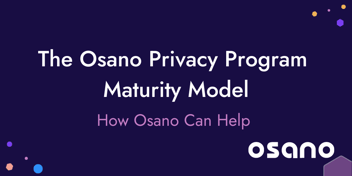
How Osano Can Help
How Osano Can Help You Mature Your Privacy Program Building, running,...
Read NowGet an overview of the simple, all-in-one data privacy platform
Manage consent for data privacy laws in 50+ countries
Streamline and automate the DSAR workflow
Efficiently manage assessment workflows using custom or pre-built templates
Streamline consent, utilize non-cookie data, and enhance customer trust
Automate and visualize data store discovery and classification
Ensure your customers’ data is in good hands
Key Features & Integrations
Discover how Osano supports CPRA compliance
Learn about the CCPA and how Osano can help
Achieve compliance with one of the world’s most comprehensive data privacy laws
Key resources on all things data privacy
Expert insights on all things privacy
Key resources to further your data privacy education
Meet some of the 5,000+ leaders using Osano to transform their privacy programs
A guide to data privacy in the U.S.
What's the latest from Osano?
Data privacy is complex but you're not alone
Join our weekly newsletter with over 35,000 subscribers
Global experts share insights and compelling personal stories about the critical importance of data privacy
Osano CEO, Arlo Gilbert, covers the history of data privacy and how companies can start a privacy program
Upcoming webinars and in-person events designed for privacy professionals
The Osano story
Become an Osanian and help us build the future of privacy!
We’re eager to hear from you
Benchmark and Grow Your Organization’s Privacy Program
Without adequate resources, there is little a privacy program or privacy professional can accomplish. It can be challenging to advocate for adequate budget, tooling, and staffing; privacy is so often seen as a cost center, and stakeholders who are unfamiliar with the demands of privacy may be inclined to reduce cost as much as possible. In a mature privacy program, privacy resources are distributed based on actual need and resourcing changes as those needs change.
When your privacy program has immature resourcing practices, there may not be a single individual whose primary role is privacy management. Instead, privacy may fall under the purview of individuals in other departments like operations, IT, or security. These individuals may address privacy concerns based on their capacity and do so in a highly reactive manner.
When there is a privacy professional, they may lack the resources required to procure the technology and tooling that they need to be effective. Not only will they have an excessive workload, but the extra work will also spill over to IT and development teams who may suffer an increased workload spent developing and maintaining in-house solutions to privacy challenges—or who may de-prioritize such solutions in favor of completing their primary responsibilities.
Due to the lack of adequate staffing and tooling, there may be significant errors in executing a given
privacy task, such as subject rights responses, or there may simply be no solution in place for regulatory requirements, such as for website cookie consent.
In an organization with mature resourcing practices, there will be adequate staffing to address the organization’s entire privacy needs. Those personnel will have access to compliance solutions that streamline the transactional, tedious, and time-consuming aspects of privacy management, such as consent management, subject rights requests, vendor onboarding and review, privacy assessments, legal documentation, and more. Moreover, the program will have cross-functional support from other stakeholders, who will themselves have adequate capacity to handle privacy responsibilities.
When fully optimized, resourcing is periodically adapted and updated such that the privacy program always has access to what it needs to be effective, but it doesn’t create an undue burden on the organization’s overall budget.
The following key steps can help you mature your organization’s privacy program resourcing:
With Osano, building, managing, and scaling your privacy program becomes simple. Schedule a demo or try a free 30-day trial today.